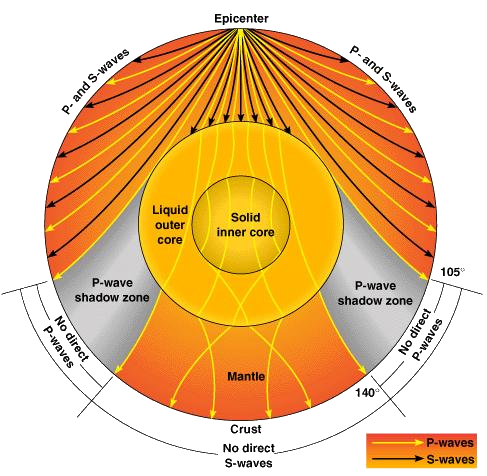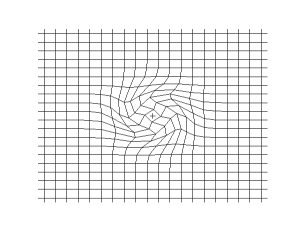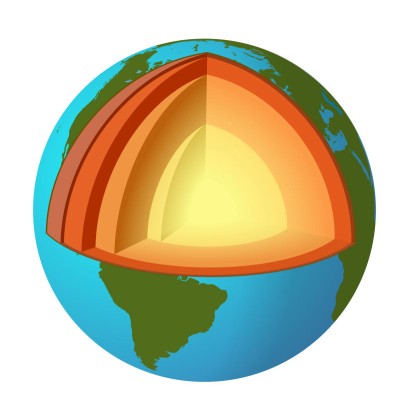Course description
The Earth – Inside and Out
 It was Isaac Newton who, in 1700, calculated the average density of the Earth, using his Theory of Gravity. He was surprised to find that it was more than double the density of rocks on the surface of our planet. It followed naturally that the inside had to be much denser than the outside and, possibly, that the Earth became progressively denser as one got nearer the centre. Newton hypothesised that the centre was made of very heavy metals which sank to the centre of the Earth through the force of gravity.
It was Isaac Newton who, in 1700, calculated the average density of the Earth, using his Theory of Gravity. He was surprised to find that it was more than double the density of rocks on the surface of our planet. It followed naturally that the inside had to be much denser than the outside and, possibly, that the Earth became progressively denser as one got nearer the centre. Newton hypothesised that the centre was made of very heavy metals which sank to the centre of the Earth through the force of gravity.
However, this was just guesswork and there was no way of knowing where denser materials started to appear inside the planet. The radius of the Earth is 6,370 kilometres but we have only been able to explore about 3.5 km beneath the surface. This has been as part of gold mining in South Africa but temperatures even at that depth are very high indeed, too high to consider going further. A drilling expedition in Russia reached 19 kilometres and then stopped.
 Answers to questions like where exactly dense materials were had to wait until measurement of the Earth’s interior was possible. You see, although the Earth sometimes throws up bits of heavy metal from as deep as 150 km (for instance, through volcanoes), this is quite rare. Most of what we know comes from observing seismic waves during and immediately after earthquakes.
Answers to questions like where exactly dense materials were had to wait until measurement of the Earth’s interior was possible. You see, although the Earth sometimes throws up bits of heavy metal from as deep as 150 km (for instance, through volcanoes), this is quite rare. Most of what we know comes from observing seismic waves during and immediately after earthquakes.
Scientists worked out from measuring the aftershocks of earthquakes that there must be three layers inside the Earth: the crust, which is the bit we actually walk around on; the mantle; and a core at the centre. The seismic waves which interest geologists are released as built-up pressure when there is an earthquake. There are two kinds: S-waves and P-waves. P-waves move in fairly straight lines, while S-waves go up and down in curves. When these waves move across different materials, they change the ways they move and this suggests what materials exist thousands of kilometers below our feet.
 One of the biggest differences between P- and S-waves is that S-waves cannot travel across liquid, while P-waves can. If the Earth were all made of the same material, waves would travel in lines, moving more slowly and weakly the further they got from the source of the earthquake. In other words, they would die out, just as waves on water become weaker and weaker the further they move from the place where a stone hits water.
One of the biggest differences between P- and S-waves is that S-waves cannot travel across liquid, while P-waves can. If the Earth were all made of the same material, waves would travel in lines, moving more slowly and weakly the further they got from the source of the earthquake. In other words, they would die out, just as waves on water become weaker and weaker the further they move from the place where a stone hits water.
A Croatian, called Andrija Mohorovičić, made careful observations of the arrivals of P- and S-waves after a major 1909 earthquake in his homeland and noticed that P-waves more than 200 km away from the epicentre arrived at higher speeds than those within a 200 km radius. These results could only be explained if the waves had travelled through something that made them speed up. This idea allowed Mohorovičić to define the first major boundary within Earth’s interior – the boundary between the crust and the denser layer below, the mantle. Seismic waves travel faster in the mantle than they do in the crust because it is composed of denser material. Although the official name of the crust-mantle boundary is the Mohorovičić discontinuity, in honour of its discoverer, it is usually called the Moho.
 Soon after, seismologists noticed that P-waves die out about 105 degrees away from an earthquake, and then reappear about 140 degrees away, arriving much later than expected. This region that lacks P-waves is called the P-wave shadow zone. S-waves, on the other hand, die out completely around 105 degrees from the earthquake. Remember that S-waves are unable to travel through liquid. The S-wave shadow zone indicates that there is a liquid layer deep within Earth that stops all S-waves but not the P-waves.
Soon after, seismologists noticed that P-waves die out about 105 degrees away from an earthquake, and then reappear about 140 degrees away, arriving much later than expected. This region that lacks P-waves is called the P-wave shadow zone. S-waves, on the other hand, die out completely around 105 degrees from the earthquake. Remember that S-waves are unable to travel through liquid. The S-wave shadow zone indicates that there is a liquid layer deep within Earth that stops all S-waves but not the P-waves.
 In 1914, Beno Gutenberg, a German seismologist, used these shadow zones to calculate the size of another layer inside of the Earth, called its core. He defined a sharp core-mantle boundary at a depth of 2,900 km, where P-waves were refracted and slowed and S-waves were stopped.
In 1914, Beno Gutenberg, a German seismologist, used these shadow zones to calculate the size of another layer inside of the Earth, called its core. He defined a sharp core-mantle boundary at a depth of 2,900 km, where P-waves were refracted and slowed and S-waves were stopped.
Inge Lehmann, a Danish geologist, in 1937 suggested that the core was actually a very solid centre, which we now think is about 2400 km wide, surrounded by a 7000 km fluid layer. By the way, that makes the Earth’s core more than twice the size of the moon. In the last few years, we have also discovered a layer between the inner and outer cores – what would we call that ‘the outer inner core’ or ‘the inner outer core’?
One final thing! In another lecture, we explore tectonic plates, chunks of the Earth’s surface that move – sometimes with dramatic effects! These are not just made of the crust but also the upper stages of the mantle! Hence earthquakes!
If you want to watch some videos on this topic, you can click on the links to YouTube videos below.
If you want to answer questions on this article to test how much you understand, you can click on the green box: Finished Reading?
Videos :
1. Newtonian Gravity (4:44)
2. Inside the Earth (5:00)
3. The Radius of the Earth (5:00)
4. Seismic Wave (5:00)
5. Andrija Mohorovicic (6:00)
6. Moho (9:00)
7. Beno Gutenberg (4:00)
8. Inge Lehmann (5:00)

 It was Isaac Newton who, in 1700, calculated the average
It was Isaac Newton who, in 1700, calculated the average Answers to questions like where exactly
Answers to questions like where exactly  One of the biggest differences between P- and S-waves is that S-waves cannot travel across liquid, while P-waves can. If the Earth were all made of the same material, waves would travel in lines, moving more slowly and weakly the further they got from the source of the earthquake. In other words, they would die out, just as waves on water become weaker and weaker the further they move from the place where a stone hits water.
One of the biggest differences between P- and S-waves is that S-waves cannot travel across liquid, while P-waves can. If the Earth were all made of the same material, waves would travel in lines, moving more slowly and weakly the further they got from the source of the earthquake. In other words, they would die out, just as waves on water become weaker and weaker the further they move from the place where a stone hits water. Soon after,
Soon after,  In 1914,
In 1914, 
















